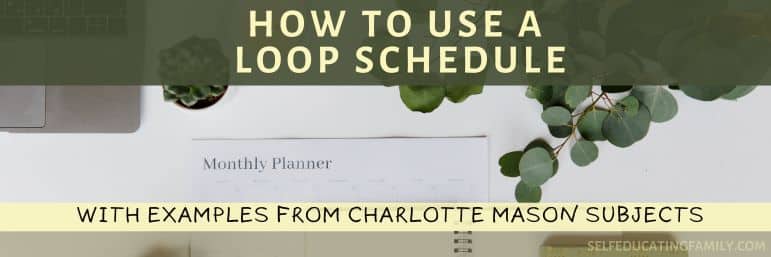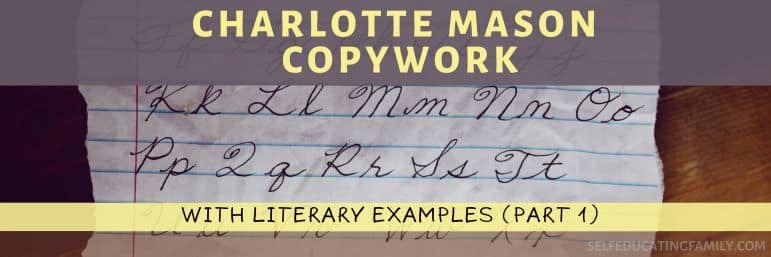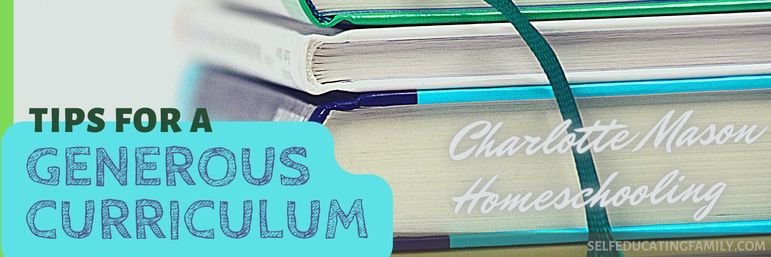Do you need to schedule a loop?
Loop scheduling!
It sounds fun, doesn’t it? Let’s look at how loop scheduling can help you.
What is a Loop Schedule?
Simply put, a loop schedule is a list of recurring items to get done:
- Task 1
- Task 2
- Task 3
You schedule time for the next task. Let’s look at an example – not homeschool related – just so you can see how it works.
Example Loop Schedule
I’ll use cleaning as an example. So here is my list of items to get done:
- Clean Bathrooms
- Sweep Floors
- Mop Floors
- Dust
- Make the kitchen sparkle
I don’t have to get each of these things done every single day, but I really want to do them once a week. Now, I could just say “Monday is Bathroom Day and Wednesday I mop” but what happens when you need to finish extended errands on Monday? And then the Monday after that is a field trip and the Monday after that your kiddo gets sick? You can’t keep putting off the cleaning of the bathroom!
Enter the Loop Schedule. Each day you carve out a specific time for “The Cleaning Loop”. It can be the same time every day, or not. There’s flexibility to this. But each day that you can, you go to the next item on the Loop, whatever comes after whatever you finished last time. In this way, you won’t go 3 weeks without a clean bathroom (unless disaster strikes and you go 3 weeks without any cleaning! This is a real possibility and DON’T you judge me! Hee hee. Just saying – I’ve been there. If it did happen, just start where you are – the next item on the list.)
So how does a Loop Schedule work for homeschooling?
Now, we take the same idea – a list of items you want to make sure you get done. Slot a time for the Loop and take it from there.
Example Homeschool Loop Schedule
Let’s say you want to make sure the directed outdoor subjects get done. Let’s face it, Charlotte Mason Homeschooling has many subjects, even if they are short.
Here’s a look at my Outdoor Charlotte Mason Loop Schedule:
- Nature Study (when we actually get out our dry brush paints and notebooks)
- Nature Walk (where we just enjoy a quiet walk around the neighborhood and work on our observation skills)
- Gardening (maybe a light walk around the garden to see what needs to be done for maintenance)
- Hike (drive to a more official nature path or longer hike)
- PE (learning or practicing a sport together)
Now, I’m not going to say we did this perfectly well. Rarely, if ever that happened. But to have the loop in place for the days when the stars aligned and it worked out was wonderful. And frankly, the more it happened, the easier it was to avoid going a whole semester and never leave the house.
Another example
Here’s a loop schedule that I used for homeschooling that actually worked very well in practice.
With Charlotte Mason methods, many of the subjects are very short. But you need to crank through them. Taking only 5–10 minutes each, here is my list for a Short Subject Loop Schedule.
- Copywork (or penmanship until they learn letter formation)
- Hymns
- Folksongs
- Recitation
- Poetry
- Composer Study
- Artist Study
- Brain Breaks (not a Charlotte Mason subject, but I used this for keeping everyone focused)
I would schedule time for two of the items per day. I felt good if we consistently averaged just over 1 a day in the week.
Details of the Short Loop
Here’s how it worked: The short subjects can be treated as types of mental breaks from the subjects that are done daily, like math or reading. Math can take up some good mental energy and it’s good to get a quick reset after math and before the next subject. So, you grab the next “short loop” item, let’s say it is Copywork. The children copy their short sentence in their copywork book. Then you move on to the next subject.
Your preparation as the director of homeschooling is to make sure they put their supplies away where they should be. This means no shirking after the short task is done. Pens and notebooks go away where they belong. You can use races for this aspect – not for the actual copywork which must be done with precision and is not a race. Finish the short task by resetting it for the next time you will come back to it.
Then later in the morning, after history, you tackle the hymn for the week. Other than just listening to hymns during family morning basket time, we found that “watching” (and signing along with) a video with the words on it helped to cement the lyrics once a week. There are a few Charlotte Mason Hymn Study Playlists on several YouTube channels.
Be sure to order your list so that you break up the list the way you want. In practice, I found that Folksongs and Hymns should be separated to add variety to the short lessons. Similarly, separate Artes and Composer studies.
So why should you Loop?
Loop scheduling can solve a few tricky areas in your homeschooling.
Problem 1: Skipping subjects
For instance, do you ever find yourself skipping the same subject every time? It may not seem like a problem now, but after two months, you will feel behind or that you should just “give up” that subject because it is too hard to fit in this semester.
Loop it instead of giving it up! This reduces your stress and increases your success.
Problem 2: No time for the fun stuff!
I felt this way until we started looping. Let’s face it, sometimes you feel like you only have the time and energy to cover the “3 Rs!” But start a loop and make sure you are giving a generous education to your child. It’s worth it.
Including those so-called “extra” subjects offers a broad and generous curriculum – vital to the little hearts and minds in your homeschool. And it’s not so bad for you, too!
Loop it!

Problem 3: I just don’t have time
Yes, you do – see above! Loop it! Loop scheduling frees up more time and gives a sense of accomplishment.
Summary
Why loop? To reduce stress, to gain hold of the elusive subjects, and to add to your success in finishing all that you want to accomplish.
Try a loop schedule in your homeschool to make your days more peaceful. I like how Pam Barnhill at Your Morning Basket puts it: Loop scheduling, on the other hand, is a way for you to reduce the stress in your homeschool that comes from skipping or missing subjects because they are assigned to specific days.
FAQ
A loop schedule uses a list of recurring homeschool subjects to cover. Go to the list for the next subject, then loop back to the top of the list when you run out of items.
I like to group my loops. One way is to group based on the amount of time in your schedule for the loop – if each subject in the loop takes about the same amount of time, then they can easily take the same block of time each day.
Block scheduling sets aside large chunks (blocks) of time for various subjects. This can allow more intensive focus on any one subject.
Both Block and Loop Schedules are useful in planning your day or your homeschool year. It may depend on what you are trying to accomplish.
Keep Learning
Get my Free Curated Poetry QuickStart Guide
Click below to go to my ItList “Add Poetry to Your Day: Quick Start Guide”. It’s free and it will help you get started with Poetry Studies.
Related articles
More resources
- Youtube hymn playlists:
- Loop vs. Block Scheduling by Pam Barnhill at Your Morning Basket
- How to set up a loop schedule
- How (and Why) To Use a Loop Schedule in Your Homeschool
- Loop Scheduling Printables for Homeschooling & More





